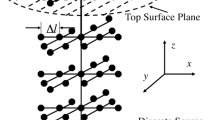Abstract
An electron beam is a widely applied processing tool in welding and additive manufacturing applications. The heat source model of the electron beam acts as the basis of thermal simulations and predictions of the micro-structures and mechanical properties of the final products. While traditional volumetric and surface heat flux models were developed previously based on the observed shape of the molten pool produced by the beam, a new heat source model with a physically informed foundation has been established in this work. The new model was developed based on Monte Carlo simulations performed to obtain the distribution of absorbed energy through electron-atom collisions for an electron beam with a kinetic energy of 60 keV hitting a Ti–6Al–4V substrate. Thermal simulations of a moving electron beam heating a solid baseboard were conducted to compare the differences between the new heat source model, the traditional surface flux model and the volumetric flux model. Although the molten pool shapes with the three selected models were found to be similar, the predicted peak temperatures were noticeably different, which will influence the evaporation, recoil pressure and molten pool dynamics. The new heat source model was also used to investigate the influence of a static electron beam on a substrate. This investigation indicated that the new heat source model could scientifically explain phenomena that the surface and volumetric models cannot, such as eruption and explosion during electron beam processing.











Similar content being viewed by others
References
Dance B, Kellar E (2010) Workpiece structure modification. U.S. Patent 7,667,158
Ge W, Guo C, Lin F (2014) Effect of process parameters on microstructure of TiAl alloy produced by electron beam selective melting. Procedia Eng 81:1192–1197
Ivanov Y, Krysina OV, Petrikova E, Petrikova E, Teresov A, Klopotov A (2014) Structure and properties of surface alloys synthesized by pulsed electron-beam treatment of a coating-substrate system. Steel Transl 44(8):573–577
Rosenthal D (1946) the theory of moving sources of heat and its application to metal treatments. Trans ASME 68:849–865
Pavelic V, Tanbakuchi R, Uyehara OA, Myers PS (1969) Experimental and computed temperature histories in gas tungsten arc welding of thin plates. Weld J Res Suppl 48:295s–305s
Paley Z, Hibbert PD (1975) Development and application of a computer program to solve the classical heat flow equation achieved results that agree well with experiment. Weld J Res Suppl 54:385s–392s
Goldak J, Chakravarti A, Bibby M (1984) A new finite element model for welding heat sources. Metall Trans B 15(2):299–305
Körner C, Attar E, Heinl P (2011) Mesoscopic simulation of selective beam melting processes. J Mater Proc Tech 211(6):978–987
Luo Y, Liu J, Ye H (2010) An analytical model and tomographic calculation of vacuum electron beam welding heat source. Vacuum 84(6):857–863
Drouin D, Couture AR, Joly D, Tastet X, Aimez V, Gauvin R (2007) CASINO V2. 42–A fast and easy-to-use modeling tool for scanning electron microscopy and microanalysis users. Scanning 29(3):92–101
Gauvin R, L’Esperance G (1992) A Monte Carlo code to simulate the effect of fast secondary electron on kAB factors and spatial resolution in the TEM. J Microsc 168:152–167
Rouquette S, Guo J, Le Masson Philippe (2007) Estimation of the parameters of a Gaussian heat source by the Levenberg–Marquardt method: application to the electron beam welding. Int J of Therm Sci 46(2):128–138
Jamshidinia M, Kong F, Kovacevic R (2013) Numerical modeling of heat distribution in the electron beam melting\(\textregistered \) of Ti–6Al–4V. J Manuf Sci Eng 135(6):061010
Cho D, Cho W, Na S (2014) Modeling and simulation of arc: laser and hybrid welding process. J Manuf Process 16(1):26–55
Yu Z, Wang Z, Yamazaki K, Sano S (2006) Surface finishing of die and tool steels via plasma-based electron beam irradiation. J Mater Proc Tech 180(1–3):246–252
Acknowledgments
The first author is now a visiting Ph.D. student at the Department of Mechanical Engineering, Northwestern University, and he would like to thank China Scholarship Council (CSC) for the financial support. The second author would like to acknowledge the support of the United States Department of Defense (DoD) in funding his Ph.D. through the National Defense Science and Engineering Graduate (NDSEG) fellowship. This work was performed under the following financial assistance award 70NANB13Hl94 from National Institute of Standards and Technology, and 70NANB14H012 from U.S. Department of Commerce, National Institute of Standards and Technology as part of the Center for Hierarchical Materials Design (CHiMaD).
Author information
Authors and Affiliations
Corresponding author
Rights and permissions
About this article
Cite this article
Yan, W., Smith, J., Ge, W. et al. Multiscale modeling of electron beam and substrate interaction: a new heat source model. Comput Mech 56, 265–276 (2015). https://doi.org/10.1007/s00466-015-1170-1
Received:
Accepted:
Published:
Issue Date:
DOI: https://doi.org/10.1007/s00466-015-1170-1




